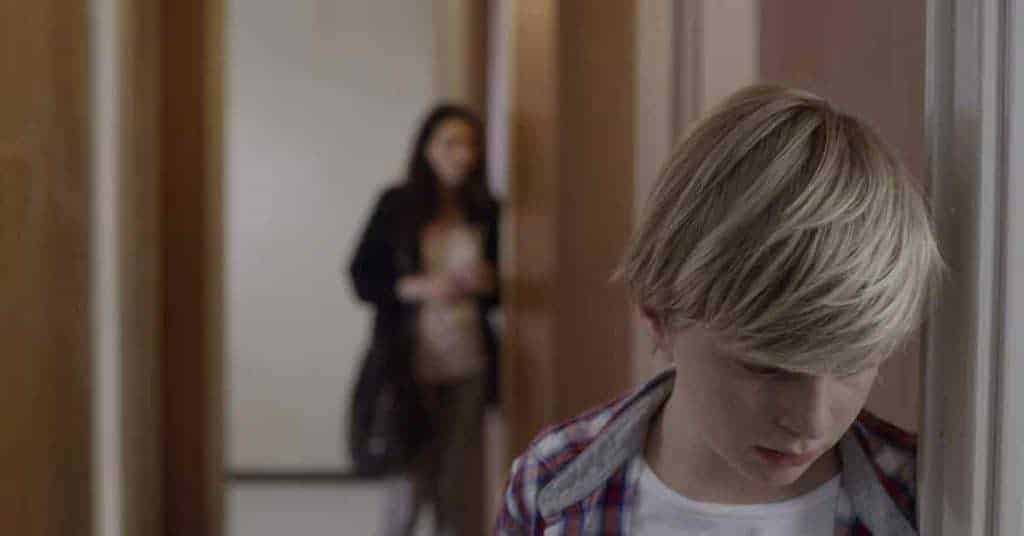Theatre actor Xavier Legrand discusses directing his first feature, Custody, mixing realism and genre, working with a young actor, and thinking in frames.

Xavier Legrand’s impressive feature debut, Custody, deservedly won the Silver Lion at its Venice Film Festival premiere. The film depicts the disastrous consequences of a custody decision, following young Julien (Thomas Gioria) and his mother, Miriam (Léa Drucker), as they try to lead a normal life despite the manipulative and violent ways of Julien’s father, Antoine (Denis Ménochet).
The film opens with a calm yet chilling sequence: the conciliation hearing to decide whether the parents will share custody of Julien. The judge had no proof of Miriam’s claim that she was physically hurt by her ex-husband, but the mention of the incident hangs over the entire film as it progresses inexorably towards an explosive ending. Custody masterfully works up the tension without ever falling into a callous treatment of a difficult issue, giving victims of abuse a voice and complexity rarely seen on the big screen.
After seeing the film at TIFF, The Seventh Row met with director Xavier Legrand in London during the London Film Festival to talk about the genesis of the film, mixing realism and genre, working with a young actor, and thinking in frames.
The Seventh Row (7R): What does the French title, Jusqu’à la garde, mean?
Xavier Legrand (XL): It has several meanings in French, but we didn’t find a way to translate that play on words to English. “La garde” in French means the custody, so “up until the custody” can refer to the time up until it is decided who will have custody of the young son, Julien.
There is also a play on words with the French expression “jusqu’à la garde” meaning “up to the hilt of the sword”, because “garde” is also the sort of handle that protects the hand when you’re holding a sword. This is why today we have this expression where if you say you’re going to do something “jusqu’à la garde,” it means you will do it to the end. There’s also a sexual meaning, where it basically means deep throat.
7R: This is your first feature length film. How did the project come about?
XL: I am a theatre actor, and I have been assistant director at the theatre, where I took a liking to directing actors and staging. So I decided to write a play.
I am passionate about Greek tragedies — with their intrigues, the family murders, etc – and so I wanted to try and write a play about what is kind of today’s equivalent. I quickly realised that domestic violence was a sort of similar violence: also in the home, and something very complicated to deal with. As a citizen and as a man, it raises a lot of questions for me. It makes me uncomfortable, angry even. So I wanted to start writing about that.
[clickToTweet tweet=”‘I am passionate about Greek tragedies — with their intrigues, the family murders, etc.’ -Legrand” quote=”‘I am passionate about Greek tragedies — with their intrigues, the family murders, etc.’ -Legrand”]
At the same time, I realised that I was not born to write theatre plays at all. This sort of writing requires a sense for language and poetry. My writing is much more linked to the action and the image. So I wrote a script, instead.
When watching fictions films and documentaries on the issue, I found that the point of view that the directors adopted to address that topic, and to invite viewers to look, was always the same: showing a man hit a woman. I thought this was the wrong way to talk about that topic. Very early on, I decided I wouldn’t talk about the domestic violence itself, but rather, about how one can escape its grip and get out of that situation.
My project was to write a trilogy, and the short film I made called Just Before Losing Everything (Avant que de tout perdre) (2013) was the first part of that trilogy. It features the same cast: Léa Drucker and Denis Ménochet. The film shows this woman on the day she decides to escape the violence of her husband and hides at her workplace with her two children.
Here, the short film format was very efficient. But after that, I had to talk about the divorce, the custody battle, and the murder attempt. The initial plan was to do that in two more short films, which would complete the trilogy. But I realised that in a short film, or even two, I wouldn’t have the time to establish things, because the divorce and the custody battles are much deeper issues to address. So I decided to merge these last two shorts into a single feature, instead. Custody thus concludes that project. It was a process that wasn’t established from the start, but matured over the years.
7R: How do you deal with the ethical question of making a fiction film about such a grave issue, involving domestic violence and abuse?
XL: I try to treat the topic with tact and decency, despite the violence inherent to it. I was confronted with a dicey topic, so I rolled up my sleeves and dealt with it. I didn’t tiptoe around it.
I read a lot of books and watched a lot of documentaries, fiction films and TV testimonials. There have been many TV shows about that.
I also went in the field and met with real victims. I attended support groups for violent men. I spent several days in the office of a judge in family affairs, to understand how conciliation hearings go and how she makes her decisions. I spent some nights at the police station, too. It really was deep investigative work.
7R: The film starts in a realist register, but becomes a sort of thriller at the end. There is a rather clear demarcation, but it feels completely natural and organic. How did you work that out?
XL: Yes, we’re not just in the social realist drama, there is also a genre film that comes out of it, too. The concept came quite early on, when I started writing the film as a feature. I thought the decision of the judge at the beginning of the film could bring to the horror at the end. Basically, I said “we’ll start like Kramer vs. Kramer (1979) and we’ll end like The Shining (1980).” The first shot is in the office of the judge, and by the end of the film we’re in the bathtub.
[clickToTweet tweet=”‘I said, ‘we’ll start like Kramer vs. Kramer (1979) and we’ll end like The Shining (1980).” -Legrand” quote=”‘I said, ‘we’ll start like Kramer vs. Kramer (1979) and we’ll end like The Shining (1980).” -Legrand”]
I then made it so that the topic would always remain the main focus of the film. But I was also careful not to stay in the “miserabilism” of the social film, so I foregrounded the genre element, which is simply fear. This was because I realised, through my investigative work, that fear was one of the main elements of this issue.
The women who are victims in those situations are afraid, and that is why they stay. This is how the genre element of the film came about — without, of course, using the easy tropes of the thriller or the horror film. It would have been easy to be spectacular and have the mother be killed at the end, but I didn’t want to make something easy and crass. This is why sheThe mother is saved at the end of the film, even though, every two-and-a-half days, a woman dies in those circumstances in France. I didn’t want to push the film to the horror; being terrified was enough.
[clickToTweet tweet=”‘All these are elements of daily anguish.’ – Xavier Legrand ” quote=”‘All these are elements of daily anguish.’ – Xavier Legrand “]
7R: There is no score at all in the film. Why is that?
XL: In my short film, there was no music at all. But I did a lot of work on sound. I wanted to use all the sounds of everyday life: the alarm of the seatbelt, the intercom, the elevator, the motor of the car. All these are elements of daily anguish.

7R: How did you work out the look of the film?
XL: It’s really instinctive. When I write, I already have an idea of how I will shoot the scene. I think in frames. The way I wanted to film was already present there.
For example, the challenge with that first scene was to find ways to make a 20 minute sequence of dialogue tense and dramatically interesting. I thought if I invite the viewers to align themselves with the judge, that means we’ll discover the parents later. I was trying every time to find something cinematic to do with the situation of the scene.
[clickToTweet tweet=”‘The challenge was to make a 20 minute sequence of dialogue tense and dramatically interesting.'” quote=”‘The challenge was to make a 20 minute sequence of dialogue tense and dramatically interesting.'”]
With the child, it’s all the scenes in the car: how do I film those sequences without repeating myself? I had to find out why the camera was in front of him, and why, in another scene, the camera was behind him.
The last part, where we’re more from the point of view of the mother, I wanted more movement and flow — longer sequences in one take, for example. All of this was in the writing.
7R: Thomas Gioria plays an extremely demanding role even though he is very young. How did you work with him?
XL: It was a long process. The casting director met with 200 boys, and I met 30 of those. As soon as I saw him, I knew he was perfect for the role. But I didn’t want to choose him yet, because I wanted to see how he would evolve throughout the various callbacks. I made the exercises at the castings a little more difficult. I realised that he had a gift, an instinct, a capacity for listening that even I was jealous of. He had been doing theater acting for three years but had never acted in a movie before.
From then on, we did a lot of preparation work, to preserve his instinctive abilities while at the same time making him understand that acting is work. Little by little, we invented the childhood this character might have had with his two parents.
We shot chronologically to make it easier for him because he had never been in a film before. But a lot of his work was also not due to me at all, but to his relationship with Denis Menochet and Lea Drucker.
He’s a child who listens really well. On the set, he was working a lot through mimicry. Léa Drucker and Denis Ménochet have very different ways of preparing for their roles. Léa wants to concentrate, and I don’t need to tell her much. Denis asks me a lot of questions and cracks jokes all the time when we’re not shooting. Thomas would alternately imitate one of the two, depending on who he was with in the scene.
I had to explain to Thomas that Denis was going to shout, and it was going to make him jump, but that it wasn’t against him: it was against the character he was playing. We had to make him understand that he should not be afraid to show that he was afraid. He had this emotion, and he had to use it for the character and cultivate it. This is a mechanism he integrated very quickly, which I realised when we shot the last sequence, in the bathtub.
[clickToTweet tweet=”‘We had to make him understand that he should not be afraid to show that he was afraid.’ -Legrand” quote=”‘We had to make him understand that he should not be afraid to show that he was afraid.’ -Legrand”]
We shot it over two days, and on the second day, we started in the bathtub. I had already shot the exterior shots of the flat — the shots of Denis trying to get in the apartment — and I had recorded all the sound: all the knocks on the door, all the shotgun shots, everything.
I replayed it all on speakers on the second day, without Denis, for Thomas and Léa, as they were inside the apartment. So I played the sound, they acted with it, got into the bathtub. After a while, during the sequence, Léa started to cry. Thomas felt it, so he started crying as well, which made Léa cry even more. During a press conference in Venice, a journalist asked Thomas where he found the emotion to do that. He gave this amazing answer: “I go look for it in my partner.”
7R: Why did you decide to have the film shift its point of view between that of the child and that of the mother?
XL: I really wanted to tell about this man and his story, but not from his point of view.
Violent men, before being violent, are also great manipulators. To have this grip on people, they know how to manipulate people. So I thought, I have to manipulate the spectator, to make viewers understand that mechanism.
[clickToTweet tweet=”‘Violent men are also great manipulators. I have to manipulate the spectator to make viewers understand that.'” quote=”‘Violent men are also great manipulators. I have to manipulate the spectator to make viewers understand that.'”]
Throughout the film, we follow the point of view of that man’s enemies: the people he wants to manipulate. At the beginning, we see from the point of view of the judge, who’s manipulated by that violent man and gives him part custody of the child. Once this violent man has custody of his son, we adopt the point of view of the child, who is in turn manipulated by his father to give information about his mother. Once the man has this information, we adopt the point of view of the mother. But through all this, we tell about the father. It’s a radical structure but I think it works for the film.
TIFF17 Review: Xavier Legrand makes a strong directorial debut with Custody

